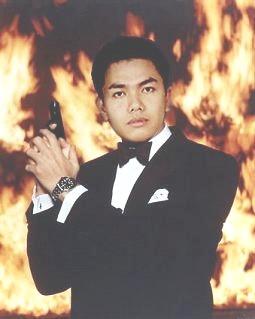Bodybuilding, or weight-training, is a sport and form of recreation in which people develop their muscles by lifting weights. By repeating exercises with progressively heavier weights, bodybuilders increase the size of their muscles. Bodybuilding is a conditioning and fitness activity. It can increase strength, speed, muscle endurance, and flexibility. When practiced correctly, bodybuilding can also strengthen the heart and improve circulation. Amateur and professional competitions are held for both men and women bodybuilders. The International Federation of Bodybuilders (IFBB) governs professional competitions. Competitors are judged in three rounds--the symmetry round, for shape, structure, and muscle proportion; the muscularity round, for size and definition of the muscles; and the posing presentation round, for poses in routines set to music. Bodybuilding differs from competitive weightlifting, in which athletes compete to determine who can lift the most weight.
PHOTO EXCLUSIVE

SUPERMAN RETURNS

DETECTIVE

BODYGUARD
Gambar-gambar ini hasil rekayasa menggunakan teknik adobe photoshop

MICHAEL JOSEPH JACKSON

POTRET SUKU ASLI / INDIGENOUS PEOPLE
Types of cameras Fixed-focus cameras, the most basic of all cameras, have a nonadjustable fixed lens. Most models have a single aperture setting and only one or two shutter speeds. Most fixed-focus cameras, including many inexpensive, pocket-sized models, use 35-millimeter or advanced photo system (APS) film. APS film has a width of 24 millimeters. It includes a magnetic coating that stores printing instructions for each photograph. Many fixed-focus cameras include a built-in automatic flash. Single-use cameras are a type of fixed-focus camera that combines a plastic lens, a shutter, film, and often a flash unit in one small box. Some are able to take pictures underwater. After the user exposes the film, he or she takes the entire camera to a photo developing laboratory. Single-lens reflex (SLR) cameras appeal to skilled amateur photographers and to professional photographers. The camera's name refers to its viewing system. The photographer views the subject as imaged by the camera lens rather than through a separate viewing lens. A mirror between the lens and the film reflects the image to the viewfinder. When the photographer presses the shutter release, the mirror lifts out of the way to allow the light to expose the film. Thus, the photographer sees almost the exact image that the camera records on film. Most SLR cameras use 35-millimeter film. Some SLR's for professional use take 120-size film. This film is 2 1/4 inches (5.7 centimeters) wide. With an SLR, a photographer can adjust the focus, select the shutter speed, and control the aperture size. Many SLR's have autofocus and automatic exposure control. Lenses on SLR cameras are interchangeable. The standard lens of an SLR camera can be replaced by special-purpose lenses that change the size and depth relationship of objects in a scene. These lenses include wide-angle lenses, telephoto lenses, macro lenses, and zoom lenses. A wide-angle lens provides a wider view of a scene than a standard lens does. A telephoto lens makes distant objects appear closer. A macro lens focuses on objects close to the lens. A view camera has a front standard (support), upon which a lens is mounted, and a rear standard, which holds the film. Between the standards is a light-tight bellows. Both the shutter and aperture are usually in the lens and are manually adjustable. A photographer focuses a view camera by moving either standard forward or backward to produce a sharp image on the viewing screen. By changing the angles of the standards, a photographer can control image shape and sharpness. Many professional photographers use view cameras for portraits, architectural images, and product photography. View camera operators use light meters that are not built into the camera. A view camera uses sheets of film that range from 2 1/4 by 3 1/4 inches (57 by 83 millimeters) to 11 by 14 inches (279 by 356 millimeters). Instant cameras use special film that does not require developing at a photo lab. The film contains all the chemicals needed for developing. The camera can thus provide a print soon after exposure. The time required to produce a print varies according to the camera and the type of film. Instant cameras provide prints ranging in size from 2 7/8 by 3 5/8 inches (73 by 92 millimeters) to 20 by 24 inches (508 by 610 millimeters). Some instant cameras can take flash pictures and focus automatically.
Digital cameras create pictures that can be instantly viewed on a screen on the camera or on a television screen, or that can be transferred to a computer. Digital cameras focus light on a reusable light-sensitive mechanism called a charge-coupled device (CCD). The CCD converts captured light patterns into a digital (numeric) code that can then be stored as a file on a floppy disk, miniature hard disk, or memory card. The user can delete images from the camera and use the digital storage space again. He or she can use computer software to manipulate the digital images. The user can also print the images or transfer them over the Internet. Motion-picture cameras take series of pictures that re-create the motion of a subject. Professional moviemakers generally use large cameras that take 70-, 35-, or 16-millimeter film. Many amateur moviemakers use portable video cameras called camcorders. These cameras convert light reflected by the subject into electronic signals that are recorded on magnetic tape. Digital camcorders may record on videotape, a memory card, or a miniature hard disk. Sound for professional motion pictures is recorded separately and later merged onto the film track. Camcorders can record sound at the same time as they record images. Most of them also have a zoom lens.
Photography is the process of making pictures by means of the action of light. Light reflected from an object forms a picture on a light-sensitive device or material. This picture is then chemically or digitally processed into a photograph. The word photography comes from Greek words meaning to write or draw with light. A photograph is basically a picture drawn with rays of light.
Camcorder is a portable, battery-powered video camera with a built-in recording mechanism. This mechanism can be a videotape recorder, a DVD recorder, or a hard drive similar to that of a computer. A camcorder captures images and sound and converts them into electronic signals for viewing on television, through some computer systems, or through the camcorder itself. A movie shot using a camcorder can be viewed immediately.
Bodybuilding, or weight-training, is a sport and form of recreation in which people develop their muscles by lifting weights. By repeating exercises with progressively heavier weights, bodybuilders increase the size of their muscles. Bodybuilding is a conditioning and fitness activity. It can increase strength, speed, muscle endurance, and flexibility. When practiced correctly, bodybuilding can also strengthen the heart and improve circulation. Amateur and professional competitions are held for both men and women bodybuilders. The International Federation of Bodybuilders (IFBB) governs professional competitions. Competitors are judged in three rounds--the symmetry round, for shape, structure, and muscle proportion; the muscularity round, for size and definition of the muscles; and the posing presentation round, for poses in routines set to music. Bodybuilding differs from competitive weightlifting, in which athletes compete to determine who can lift the most weight.
|

